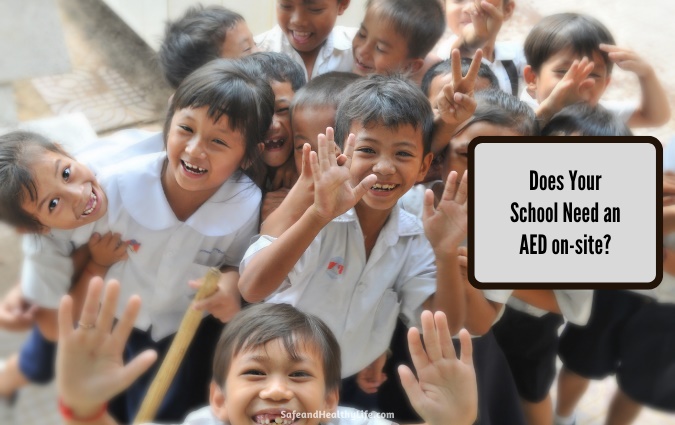Does Your School Need an AED on-site?

The truth is, cardiac arrests can occur to anyone at any time, and the outcome is not great for those who suffer from one outside of a hospital.
For the best chances of survival, CPR needs to be commenced within the first few vital minutes, with defibrillation shortly thereafter.
A lot of places do have AEDs onsite, but what about schools?
Here is everything you need to know about AEDs and schools here in Australia.
What is an AED?
An AED is an abbreviated term used for an Automated External Defibrillator. It is a user-friendly, small, portable device that is used to administer life-saving electric shocks to someone who is in cardiac arrest.
It analyses the person’s heart rhythm and autonomously delivers electric shocks between manual compressions.
What is a cardiac arrest?
A cardiac arrest is when the heart stops beating. It is a life-threatening event that has a very low survival rate.
As the heart cannot pump blood around the body, the brain and vital organs are deprived of oxygen. Tissue damage occurs within minutes and often, it is irreversible.
Every second counts, and the longer the casualty is left without intervention, the poorer the outcome. If CPR and a defibrillator are not used quickly, the odds of survival are not good.
Signs that someone is in cardiac arrest
Cardiac arrests can happen quickly with or without warning. Here are some of the signs that someone is in cardiac arrest:
- They are not breathing or they may be gasping for air
- They are unresponsive or unconscious and cannot be woken
- They have no pulse
- They’ve collapsed and fallen to the ground
What do you do when someone goes into cardiac arrest?
Call 000 immediately, if someone else is there, get them to do it and to grab the AED so you can start CPR straight away.
Even if you have no prior training or your training is outdated, by acting quickly, you can increase the chances of survival. Remember, doing something is better than doing nothing.
Here’s what you do:
- As mentioned, call for help on 000, requesting an ambulance.
- Start CPR. Push hard and deeply into the center of the chest using both hands.
- Turn on the AED, or get someone to do it if they are there so you don’t have to stop CPR. Follow the directions as you are prompted from the AED.
This should be continued until paramedics arrive to take over. The emergency call-taker will stay on the line with you, directing you as you go, so there is no uncertainty. They will stay on the line with you until help arrives.
Do Australian schools need an AED on-site?
Having an AED onsite at schools across Australia is highly recommended however, they are not mandated. The choice to have one or not comes down to the individual school. Some schools decide to implement an AED based on a risk assessment.
For example, in high-risk settings, remote areas, staff or students with prior cardiac arrest would typically have one.
When would an AED be needed?
An AED is used in conjunction with other life-saving responses such as CPR. An AED would be used when a person is:
- Not breathing or breathing irregularly
- Unresponsive or unconscious
- Eight years old or older.
- Not showing any signs of life, ie, moving.
Who in the school can use an AED?
While AEDs are designed to be easy to use, they should be used by someone who has sufficient CPR training if possible.
This allows the steps to be followed correctly and with confidence. Typically, this would be the school’s designated first aid responder.
However, their use should not be restricted to trained personnel. Acting immediately rather than waiting for the trained responder will increase the chances of survival for the patient.
All staff should have an understanding of what an AED is and what actions should be taken in case of an emergency.
Where should an AED be kept in a school?
It is advised that schools should keep the AED in an accessible and visible area such as the administration/reception area. It should be wall-mounted and contained in a hard case to protect it.
Additionally, AEDs need the batteries to be checked each month and changed when necessary. Each component of the AED should be checked to ensure it is working properly.
How much does an AED cost?
AEDs come in various styles and types, and the price can vary depending on which one you choose. To give you an idea, they typically start at around the $1,300 mark and go up from there.
Keeping in mind that the batteries need to be changed on schedule and the pads are one-time use and they do have an expiry date, some brands are longer than others, so it is important to be mindful of this.
AEDs should be in every school
While Australian schools don’t need to have an AED on-site, it can be highly beneficial if they do.
If someone happens to go into cardiac arrest on the school grounds, they have a much better chance of survival with the intervention of CPR and a defibrillator.
If you have any questions about defibrillators for schools, reach out to our knowledgeable team here at
The First Aid Shop. For all of your first aid supplies, AEDs included, check out our website!
About The Author:
Andy has been the director of The First Aid Group since 2016. Holding multiple diplomas and certificates in first aid and emergency services, Andy carries a myriad of skills in first aid management. Andy is an enthusiastic member of the First Aid Industry Reference Committee and the Australian Resuscitation Council. Andy is passionate about Professional Development and seeing people become fully equipped in their first aid training.

